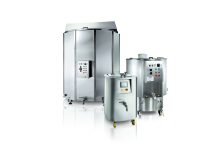Mycotoxins are toxic substances of natural origin, metabolites of moulds of the genders Aspergillus, Penicillium and Fusarium. Foods that are more often contaminated by mycotoxins, as gathered from the RASFF (European Rapid Alert System for Food and Feed) website, are tree nuts (pistachios, almonds, peanuts), dried fruit (dry figs, raisins), cereals (corn, wheat, barley, rye, and the products obtained from their flours), cocoa, coffee, grape and wine. Currently known mycotoxins are some tens of molecules, but legislative limits in foods are present only for a few of them. Some problems that are encountered during mycotoxins determination in foods are the following:
 1. The growth of mycotoxins-producing moulds in food produce happens in very circumscribed spatial areas, where as a result the contamination is incredibly high, whereas a few cm away from that area contamination could be nil; therefore it is extremely difficult to perform a representative sampling.
1. The growth of mycotoxins-producing moulds in food produce happens in very circumscribed spatial areas, where as a result the contamination is incredibly high, whereas a few cm away from that area contamination could be nil; therefore it is extremely difficult to perform a representative sampling.
2. Being mycotoxins extremely toxic substances, some of them have very low legislative limits (in the order of a few ppb, that is µg/kg), therefore very efficient and sensitive extractive and instrumental methods are required in order to analyze them.
3. Some mycotoxins bond to food constituents, therefore they are “masked” during extraction and analysis, leading to underestimating their presence. During digestion in the human gastrointestinal tract, they are probably unbounded from food constituents and return to their free, toxic form. Mycotoxins acute toxic effects, both in animals and in humans, happen only at fairly high doses. On the contrary, very often the small doses of these substances found in food generate chronic effects, including carcinogenicity. Mycotoxins level in produce depends on many factors, since mould growth needs certain conditions to happen (temperature, humidity and sufficient time). E.g. regarding cereal contamination, in some geographic areas or in certain years characterized by high humidity, mould growth is remarkable, with consequent high mycotoxins levels in the harvests. In Europe, in some recent years the contaminated harvests reached levels as high as 40-50% of the total. In the past, those percentages were even higher, with peaks of 80-90% of contaminated harvests for some mycotoxins particularly common on certain sensitive cereals (e.g deoxynivalenol is the most common in Europe, including Italy, on wheat). Over time, understanding these moulds growth factors allowed to improve agronomic and grains stocking practices in order to avoid as much as possible their presence and spreading. However some years with high precipitations are still critical, and high levels of mycotoxins are present as a result. Besides the toxic and carcinogenic effect on humans, mycotoxins have toxic effect on farm animals, leading to remarkable economic loss for farmers.




